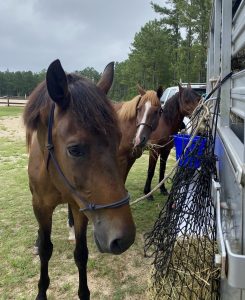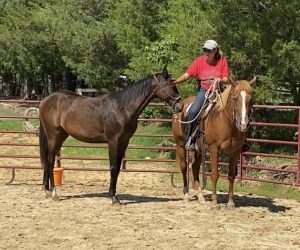Editor’s Note: Amy Skinner is a regular guest columnist and has been a horse gal since age six. She has presented twice at the Best Horse Practices Summit and is the author of To Catch a Horse: Finding the Heart of your Horsemanship.
 She rides and teaches dressage and Western. Skinner has studied at the Royal Andalusian School of Equestrian Art in Spain, with Brent Graef, Leslie Desmond, and many others. Visit her website here.
She rides and teaches dressage and Western. Skinner has studied at the Royal Andalusian School of Equestrian Art in Spain, with Brent Graef, Leslie Desmond, and many others. Visit her website here.
Amy Skinner writes:
Herd-bound issues are common concerns among horse owners and riders. Concerns range from the horse whinnying to herdmates and looking around, to more dangerous behaviors like bolting, bucking, and running back to the barn. Every rider has dealt with it to some degree. What can be done? Popular suggestions run the gamut from harsher equipment to working them harder near their friends.
First, it’s important to understand why a horse could feel herd-bound. Horses’ security comes from numbers and having the herd watch out as a collective takes the strain off of the individual. Because of this group watch, horses are able to nap, eat, and relax. When a horse is alone, the burden of their safety is completely its own. They may become hyper vigilant and wary of things that horses wouldn’t normally worried about. This is when people may describe the horse as “spooking at nothing,” or, even worse, “making up things to spook at.”
 From the moment we halter a horse and take it from the herd, its concern for safety increases dramatically. The horse’s safety is literally in our hands. A person’s impatience, fear of the horse’s behavior, or lack of clear guidance all add to the horse’s concerns.
From the moment we halter a horse and take it from the herd, its concern for safety increases dramatically. The horse’s safety is literally in our hands. A person’s impatience, fear of the horse’s behavior, or lack of clear guidance all add to the horse’s concerns.
It’s inaccurate and anthropomorphic to say that the horse is looking for a herd leader at this point. Nonetheless, a horse does thrive on support and guidance. A scared rider who is in over their head cannot support a horse. Also, a horse who is fearful isn’t able to take in new information. They may be ‘learning’ to evade, escape, worry, and to be reinforced in their belief that security comes only from the herd.
What to do?
The answer is highly individual.
How you go about supporting a herd-bound horse depends on your ability, the horses level of worry, your set-up, and other factors. But here are some important things that should be happening in each session:
- The horse should be getting at least a little more relaxed with each session.
- The horse should be kept under their threshold of panic.
- The rider should maintain their own composure and safety as a priority.
- The rider should keep the exercises at a level that won’t overwhelm.
 When I have a herd-bound horse, I consider his overall ability to feel secure. Has he been provided with the right kind of herd?
When I have a herd-bound horse, I consider his overall ability to feel secure. Has he been provided with the right kind of herd?
Ideally, I’d like him to be with confident, calm horses that can lend some of their attitude to him. Then, I want to give this horse a good foundation of the meaning of the lead rope, bridle, and other aids. I want this to develop in an environment he’s comfortable in so he can learn well. If it has to be in his pasture initially, that’s fine with me.
Once I know this horse has a good herd and understands the basics, I start working to expand his level of comfort outside the herd. I always try to remain under the threshold of panic. If he’s very herd-bound, I might not get very far. I watch the horse’s expression to see where his concern comes up, and I stay there or may get a little closer to the herd.
Then, I may work on groundwork he knows well. I want to keep the work very simple, and I move in a way that doesn’t amplify his worries. A nervous horse may interpret movements louder than they were intended, so I take caution to move quietly. I don’t restrict their movement, but don’t encourage blasting around either, which is why basic groundwork is an excellent tool here. Once they are a little more relaxed I head a bit closer to their herd.
 I want them to learn to breathe, lick and chew, and relax with the realization that they are not being removed from their herd. I might repeat this until it’s no big deal, and put the horse away feeling calm and relaxed. Again, if we are only a few feet away from the pasture, I don’t mind at all.
I want them to learn to breathe, lick and chew, and relax with the realization that they are not being removed from their herd. I might repeat this until it’s no big deal, and put the horse away feeling calm and relaxed. Again, if we are only a few feet away from the pasture, I don’t mind at all.
If I get one percent improvement each session, I’m thrilled. I don’t expect too much. One percent daily improvement, after all, is excellent progress over 100 days. It’s much better than regression, which will happen if I ask for too much, if I make the horse more worried and cause him lose confidence. I’ve regretted going to fast but never too slowly.
I have heard several times that mares should be kept with mares and geldings with geldings to reduce the tendency to display herd bound behavior. Is there any truth to this, or is it specific to each individual horse regardless of gender grouping?
Hi Amy, I’ve maintained herds with both sexes as well as all mares. I’ve never noticed a difference in how herd bound behavior is displayed vis a vis gender.
In general, gender bias (of horse owners’ beliefs for what exists among horses) is grossly unfounded. I believe herd-bound issues have more to do with individual horses, their experiences and treatment. Thanks again for your comment and question.
Thank you. Good information.
Thank you Amy! I haven’t had to deal with a herd bound horse in many years, and I must say it is so much better for the horse and for me when you aren’t dealing with a herd bound horse whenever you want to go somewhere.
Great blog, thnx!!
love this! Thanks!